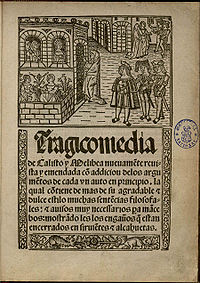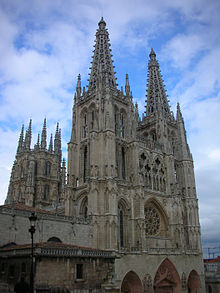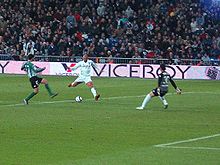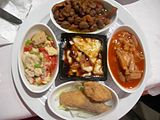- Culture of Spain
-
The culture of Spain is based on a variety of influences.
The Visigothic Kingdom left a sense of a united Christian Hispania that was going to be welded in the Reconquista. Muslim influences were strong during the period of 711 AD to the 15th century, especially linguistically. The Spanish language derives directly from Vulgar Latin and has minor influences from pre-Roman languages like Gothic, Arabic, and Basque. Another influence was the minority Jewish population in some cities, but after the defeat of the Muslims during the Christian Reconquista ("Reconquest") period between 1000 and 1492, Spain became an almost entirely Roman Catholic country. In addition, the history of the nation and its Mediterranean and Atlantic environment have played a significant role in shaping its culture.
By the end of the 19th and 20th centuries, the Spaniards made expressions of cultural diversity easier than it had been for the last seven centuries.[clarification needed] This occurred at the same period that Spain became increasingly drawn into a diverse international culture. Spain has the second highest number of UNESCO World Heritage Sites in the world, with a total of 42.[1]
Contents
Literature
Literature of Spain • Medieval literature • Renaissance • Miguel de Cervantes • Baroque • Enlightenment • Romanticism • Realism • Modernismo • Generation of '98 • Novecentismo • Generation of '27 • Literature subsequent to the Civil War The term "Spanish literature" refers to literature written in the Spanish language, including literature composed by Spanish and Latin American writers. It may include Spanish poetry, prose, and novels.
Spanish literature is the name given to the literary works written in Spain throughout time, and those by Spanish authors worldwide. Due to historic, geographic, and generational diversity, Spanish literature has known a great number of influences and is very diverse. Some major movements can be identified within it.[examples needed]
Highlights include the Cantar de Mio Cid, the oldest preserved Spanish cantar de gesta. It is written in medieval Spanish, the ancestor of modern Spanish.
The Celestina is a book published anonymously by Fernando de Rojas in 1499. This book is considered to be one of the greatest in Spanish literature, and traditionally marks the end of medieval literature and the beginning of the literary renaissance in Spain.
Besides its importance in the Spanish literature of the Golden Centuries, Lazarillo de Tormes is credited with founding a literary genre, the picaresque novel, so called from Spanish pícaro, meaning "rogue" or "rascal". In these novels, the adventures of the pícaro expose injustice while simultaneously amusing the reader.
Published by Miguel de Cervantes in two volumes a decade apart, Don Quixote is the most influential work of literature to emerge from the Spanish Golden Age and perhaps the entire Spanish literary canon. As a founding work of modern Western literature, it regularly appears at or near the top of lists of the greatest works of fiction ever published.
Painting and sculpture
Spain's greatest painters during the Golden age period included El Greco, Bartolomé Esteban Murillo, Diego Venezuela, and Francisco Goya, who became world-renowned artists between the period of the 16th century to 19th century. However, Spain's best known artist since the 20th century has been Pablo Picasso, who is known for his abstract sculptures, drawings, graphics, and ceramics in addition to his paintings. Other leading artists include Salvador Dalí, Juan Gris, Joan Miró, and Antoni Tàpies.
Architecture
During the Prehistoric period, the megalithic Iberian and Celtic architectures developed. Through the Roman period, both urban development (ex. the Emerita Augusta) and construction projects (ex. the Aqueduct of Segovia) flourished. After the pre-Romanesque period, in the architecture of Al-Andalus, important contributions were made by the Caliphate of Córdoba (the Great Mosque of Córdoba), the Taifas (Aljafería, in Zaragoza), the Almoravids and Almohads (La Giralda, Seville), and the Nasrid of the Kingdom of Granada (Alhambra, Generalife).
Spanish architecture encompasses a wide range of both secular and religious styles from the foundation of Islam to the present day, influencing the design and construction of buildings and structures in Islamic culture. The principal Islamic architectural types are the mosque, the tomb, the palace and the fort. From these four types, the vocabulary of Islamic architecture is derived and used for buildings of lesser importance such as public baths, fountains, and domestic architecture.[1][2]
Islamic art prohibited the painting of people or figures, so beautiful designs and floral patterns covered every wall of important buildings. Art was very important in Spain at that time. The three main religions in Spain then were Islam, Christianity, and Judaism. The places of worship involved all three different aspects.[examples needed]
Later, several currents appear: the Mudéjar Style (ex. the Alcázar of Seville), the Romanesque period (ex. the Cathedral of Santiago de Compostela), the Gothic period (ex. the Cathedrals of Burgos, León and Toledo), the Renaissance (Palace of Charles V in Granada), the Baroque period (Granada Cathedral), the Spanish colonial architecture, and Neoclassical style (ex. the Museo del Prado) are the most significant. In the 19th century eclecticism and regionalism, the Neo-Mudéjar style and glass architecture bloom. In the 20th century, the Catalan Modernisme (ex. La Sagrada Família by Gaudí), modernist architecture, and contemporary architecture germinated.
Cinema
The art of motion picture making within the nation of Spain or by Spanish filmmakers abroad is collectively known as "Spanish cinema".
In recent years, Spanish cinema has achieved high marks of recognition as a result of its creative and technical excellence. In the long history of Spanish cinema, the great filmmaker Luis Buñuel was the first to achieve universal recognition, followed by Pedro Almodóvar in the 1980s. Spanish cinema has also seen international success over the years with films by directors like Segundo de Chomón, Florián Rey, Luis García Berlanga, Carlos Saura, Julio Medem and Alejandro Amenábar. Woody Allen, upon receiving the prestigious Prince of Asturias Award in 2002 in Oviedo remarked: "when I left New York, the most exciting film in the city at the time was Spanish, Pedro Almodovar's one. I hope that Europeans will continue to lead the way in filmmaking because at the moment not much is coming from the United States."
Non-directors have obtained less international notability. Only the cinematographer Néstor Almendros, the actress Penélope Cruz and the actors Fernando Rey, Antonio Banderas, Javier Bardem and Fernando Fernán Gómez have obtained some recognition outside of Spain. Mexican actor Gael García Bernal has also recently received international notoriety in films by Spanish directors.
Today, only 10 to 20% of box office receipts in Spain are generated by domestic films, a situation that repeats itself in many nations of Europe and the Americas. The Spanish government has therefore implemented various measures aimed at supporting local film production and movie theaters, which include the assurance of funding from the main national television stations. The trend is being reversed with the recent screening of mega productions such as the €30 million film Alatriste (starring Viggo Mortensen), the Academy Award winning Spanish/Mexican film Pan's Labyrinth (El Laberinto del Fauno), Volver (starring Penélope Cruz), and Los Borgia (€10 million), all of them hit blockbusters in Spain.
Another aspect of Spanish cinema mostly unknown to the general public is the appearance of English-language Spanish films such as The Machinist (starring Christian Bale) The Others (starring Nicole Kidman), Basic Instinct 2 (starring Sharon Stone), and Milos Forman’s Goya's Ghosts (starring Javier Bardem and Natalie Portman). All of these films were produced by Spanish firms. This attests to the dynamism and creativity of Spanish directors and producers.
- The following category is a list of percentages of attendance and gross revenues.
Year Total number of spectators (millions) Spectators of Spanish cinema (millions) Percentage Film Spectators (millions) Percentage over the total of Spanish cinema 1996 96.2 10.4 10.8% Two Much
(Fernando Trueba)2.1 20.2% 1997 107.1 13.9 14.9% Airbag
(Juanma Bajo Ulloa)2.1 14.1% 1998 119.8 14.1 13.3% Torrente, the stupid arm of the law
(Santiago Segura)3 21.3% 1999 131.3 18.1 16% All About My Mother
(Pedro Almodóvar)2.5 13.8% 2000 135.3 13.4 11% Commonwealth
(Álex de la Iglesia)1.6 11.9% 2001 146.8 26.2 17.9% The Others
(Alejandro Amenábar)6.2 23.8% 2002 140.7 19.0 13.5% The Other Side of the Bed
(Emilio Martínez Lázaro)2.7 14.3% 2003 137.5 21.7 15.8% Mortadelo & Filemón: The Big Adventure
(Javier Fesser)5.0 22.9% 2004 143.9 19.3 13.4% The Sea Inside
(Alejandro Amenábar)4.0 20.7% 2005 126.0 21.0 16.7% Torrente 3: The Protector
(Santiago Segura)3.6 16.9% 2006 (provisional) 67.8 6.3 9.3% Volver
(Pedro Almodóvar)1.8 28.6% Language
Castilian
"Spanish" (
 españa (help·info)) or "Castilian" (Castellano) is a Romance language originally from the northern area of Spain. From there, its use gradually spread inside the Kingdom of Castile, where it evolved and eventually became the principal language of the government and trade. It was later taken to Africa, the Americas and the Philippines when they were brought under Spanish colonial rule between the 15th and 19th centuries.
españa (help·info)) or "Castilian" (Castellano) is a Romance language originally from the northern area of Spain. From there, its use gradually spread inside the Kingdom of Castile, where it evolved and eventually became the principal language of the government and trade. It was later taken to Africa, the Americas and the Philippines when they were brought under Spanish colonial rule between the 15th and 19th centuries.Today, it is one of the official languages of Spain, most Latin American countries and Equatorial Guinea. In total, 21 nations use Spanish as their primary language. Spanish is also one of six official languages of the United Nations.
Catalan or Valencian
"Catalan", with its "Valencian" dialect is a Romance language, the national language of Andorra, and a co-official language in the Spanish autonomous communities of The Balearic Islands, Catalonia and Valencian Community, and in the city of Alghero in the Italian island of Sardinia. It is also spoken, although with no official recognition, in the autonomous communities of Aragon (in La Franja) and Murcia (in Carche) in Spain, and in the Roussillon region of southern France, which is more or less equivalent to the département of the Pyrénées-Orientales.
Basque
Basque (Euskera or Euskara) is a non-Indo-European language. Until the 1970s it was in recession, but with the democracy it is taught in schools and it is more common to hear Basque in the cities and in the areas where it was lost.[clarification needed]
Basque is the only non-Indo-European language in all of western Europe. The origins of this language are unknown. It is thought that the language was spoken before the Romans came to the Iberian Peninsula.
Galician
Galician (Galician: Galego [ɡaˈleɡo]) is a language of the Western Ibero-Romance branch, spoken in Galicia, an autonomous community with the constitutional status of "historic nationality," located in northwestern Spain and small bordering zones in neighbouring autonomous communities of Asturias and Castilla y León.
Galician and Portuguese were, in medieval times, a single language which linguists call Galician-Portuguese, Medieval Galician, or Old Portuguese, spoken in the territories initially ruled by the medieval Kingdom of Galicia. Both languages are even today united by a dialect continuum[citation needed] located mainly in the northern regions of Portugal.
Aranese
Aranese (Occitan: Aranés) is a standardized form of the Pyrenean Gascon variety of the Occitan language spoken in the Val d'Aran, in north western Catalonia on the border between Spain and France, where it is one of the three official languages besides Catalan and Spanish.
Other languages
Other languages of Spain:[2]
- Astur-Leonese
- Aragonese
- Caló language (Spanish Romani)
- Extremaduran
- Fala language
- Quinqui jargon
Religion
About 79% of Spaniards identify as belonging to the Roman Catholic religion; 2% identify with another religious faith, and about 19% as non-religious.[3]
Holidays
The most important Spanish holiday is "Semana Santa" (Holy Week), celebrated the week before Easter with large parades and other religious events. Spaniards also hold celebrations to honour their local patron saints in churches, cities, towns and villages. The people decorate the streets, build bonfires, set off fireworks and hold large parades, bullfights, and beauty contests.
One of the best known Spanish celebrations is the festival of "San Fermin," which is celebrated every year in July in Pamplona. Bulls are released into the streets, while people run ahead of the animals to the bullring.
Sport
Association Football is highly appreciated and it is regarded to be the most popular contemporary recreation in the country. Notable teams include Atlético de Madrid, FC Barcelona, Real Sociedad, Valencia CF and Real Madrid C. F..
Cuisine
A significant portion of Spanish cuisine derives from the Roman, Jewish, and Arab traditions. The Moorish people were a strong influence in Spain for many centuries. However, pork is popular and for centuries eating pork was also a statement of Christian ethnicity or "cleanliness of blood", because it was not eaten by Jews or Muslims. Several native foods of the Americas were introduced to Europe through Spain, and a modern Spanish cook could not do without potatoes, tomatoes, peppers, and beans. These are some of the primary influences that have differentiated Spanish cuisine from Mediterranean cuisine, of which Spanish cuisine shares many techniques and food items.
The essential ingredient for real Spanish cooking is olive oil, as Spain produces 44% of the world's olives. However, butter or lard are also important, especially in the north.
Daily meals eaten by Spaniards in many areas of the country are still very often made traditionally by hand, from fresh ingredients bought daily from the local market. This practice is more common in the rural areas and less common in the large urban areas like Barcelona or Madrid, where supermarkets are beginning to displace the open air markets. However, even in Madrid food can be bought from the local shops; bread from the "panadería" and meat from the "carnicería".
One popular custom when going out is to be served tapas with a drink, including sherry, wine and beer. In some areas, like Almería, Granada or Jaén in Andalusia and Madrid or Salamanca in the centre tapas are given for free with a drink and have become very famous for that reason. It should be noted that almost every bar serves something edible when a drink is ordered, without charge. However many bars exist primarily to serve a purchased "tapa".
Another traditional favorite is the churro with a mug of thick hot chocolate to dip churros in. "Churrerías," or stores that serve churros, are quite common. The Chocolatería San Ginés in Madrid is especially famous as a place to stop and have some chocolate with churros, often late into the night (even dawn) after being out on the town. Often traditional Spanish singers and musicians will entertain the guests. [1]
As is true in many countries, the cuisines of Spain differ widely from one region to another, even though they all share certain common characteristics, which include:
- The use of olive oil as a cooking ingredient in items such as fritters. It is also used raw.
- The use of sofrito to start the preparation of many dishes.
- The use of garlic and onions as major seasonings.
- The custom of drinking wine during meals.
- Serving bread with the vast majority of meals.
- Consumption of salads, especially in the summer.
- The consumption of a piece of fruit or a dairy product as dessert. Desserts such as tarts and cakes are typically reserved for special occasions.
Education
Obligatory education
Age Name Primary Education 5-6 1st grade 6-7 2nd Grade 8-9 3rd Grade 9-10 4th Grade 10-11 5th Grade 11-12 6th Grade Secondary School 12-13 First grade 13-14 Second grade 14-15 Third grade 15-16 Fourth grade Optional education: Bachillerato
- Common subjects are in red
- Optional Subjects are in pink
- Modality Subjects are in blue
- Technology Via are in yellow
- Natural Sciences Via are in green
- Humanities Via are in olive
- Social Sciences Via are in brown
- Arts Via are in beige
Natural Sciences/Technology Humanities and Social Sciences Arts Physics History/Geography Chemistry Economy Technical drawing Biology Maths Painting Maths Latin Sculpture Technology Ancient Greek Audiovisual Technical drawing Art History 2nd Foreign Language French, German, Italian Communication and Information Technologies Psychology Spanish Language Philosophy 1st Foreign Language Physical Education only the first year Autonomical Languages (only in the autonomies where is spoken) Catalan, Valencian, Basque, Galician Religion only the first year Politics
Spain is a democratic parliamentary constitutional monarchy. The monarch is the head of state, and the president of the government is the head of government. There are multiple parties and free elections. Executive power is vested in the government. Central legislative power is vested in the two chambers of parliament. The judiciary is independent of the executive and the legislative powers.
Regionalism
A strong sense of regional identity exists in many regions of Spain. These regions or nationalities—even those that least identify themselves as Spanish—have contributed greatly to many aspects of mainstream Spanish culture.
Most notably, the Basque Country and Catalonia have widespread nationalist sentiment. Many Basque and Catalan nationalists demand statehood for their respective territories. Basque aspirations to statehood have been a cause of violence (notably by ETA), although most Basque nationalists (like virtually all Catalan nationalists) currently seek to fulfill their aspirations peacefully.
There are also several communities where there is a great sense of regional identity: Galicia, Andalusia, Asturias, Navarre, Aragon, Balearic Islands and Valencia (the last two feeling attached to Catalan culture in different ways) each have their own version of nationalism, but generally with a smaller percentage of nationalists than in the Basque Country and Catalonia.
There are other regions which, despite a broad Spanish nationalist feeling, have strong regional identities: Cantabria, Rioja, and Extremadura.
There are also the cases of Madrid, an administrative autonomous community inside the two Castilles; the two north African autonomous cities of Ceuta and Melilla, and the autonomous community of Murcia. Castile was the core kingdom under which Spain eventually unified after centuries of evolution and incorporations. Yet there are also strong movements in the provinces of the extinct region of Leon, pushing to separate from Castile and León.
Spain has a long history of tension between centralism and regionalism. The current organisation of the state into autonomous communities (similar to a federal organisation) under the Spanish Constitution of 1978 is intended as a way to incorporate these communities into the state.
While everyone in Spain can speak Spanish, other languages figure prominently in many regions: Basque or Euskara in the Basque Country and Navarre; Catalan in Catalonia, Balearic Islands and Valencia (where it is usually referred to as Valencian), and Galician in Galicia. Spanish is official throughout the country; the rest of these have co-official status in their respective regions and all are major enough that there are numerous daily newspapers in these languages and, especially in Catalan, a significant book publishing industry. Many citizens in these regions consider their regional language as their primary language and Spanish as secondary; these languages cover broad enough regions to have multiple distinct dialects. Spanish itself also has distinct dialects around the country, with the Andalusian ('Andaluz') dialect being closer to the Spanish of the Americas, which it heavily influenced.
See also
References
- ^ "World Heritage List". UNESCO. http://whc.unesco.org/en/list. Retrieved 2008-08-13.
- ^ http://www.ethnologue.com/show_country.asp?name=ES
- ^ "CIS last study on religion, 2005, question no. 35" (in Spanish). 2005. http://www.cis.es/cis/opencms/-Archivos/Marginales/2600_2619/e260200.html. Retrieved 2009-07-02.[dead link]
External links
- Official Spanish Culture Website 162,000 pages of information.
- Spain Cultural Blog
Culture of Europe Sovereign
states- Albania
- Andorra
- Armenia
- Austria
- Azerbaijan
- Belarus
- Belgium
- Bosnia and Herzegovina
- Bulgaria
- Croatia
- Cyprus
- Czech Republic
- Denmark
- Estonia
- Finland
- France
- Georgia
- Germany
- Greece
- Hungary
- Iceland
- Ireland
- Italy
- Kazakhstan
- Latvia
- Liechtenstein
- Lithuania
- Luxembourg
- Macedonia
- Malta
- Moldova
- Monaco
- Montenegro
- Netherlands
- Norway
- Poland
- Portugal
- Romania
- Russia
- San Marino
- Serbia
- Slovakia
- Slovenia
- Spain
- Sweden
- Switzerland
- Turkey
- Ukraine
- United Kingdom
- (England
- Northern Ireland
- Scotland
- Wales)
- Vatican City
States with limited
recognition- Abkhazia
- Kosovo
- Nagorno-Karabakh
- Northern Cyprus
- South Ossetia
- Transnistria
Dependencies
and other territories- Åland
- Faroe Islands
- Gibraltar
- Guernsey
- Jan Mayen
- Jersey
- Isle of Man
- Svalbard
Other entities - European Union
Categories:- Spanish culture
Wikimedia Foundation. 2010.




